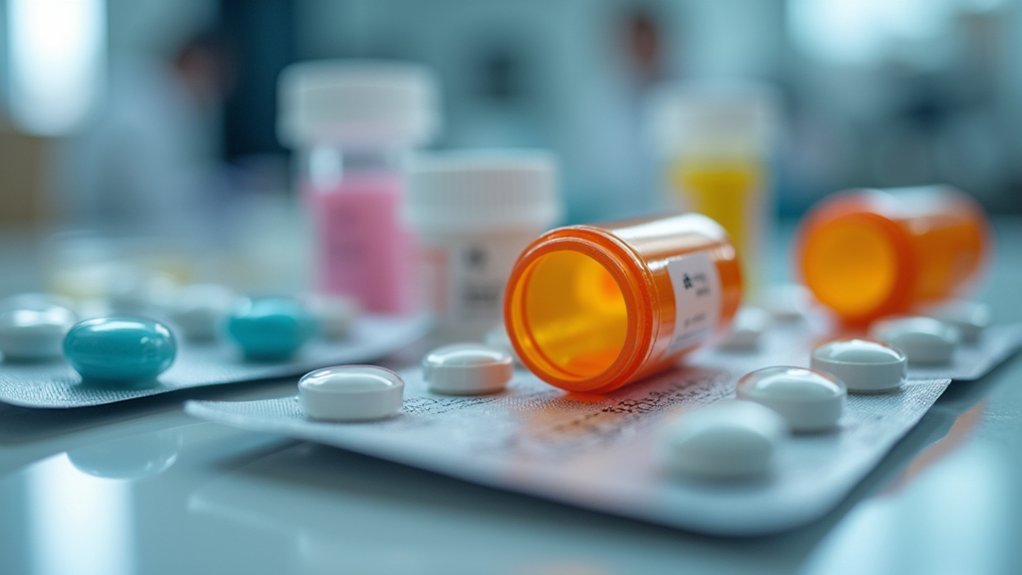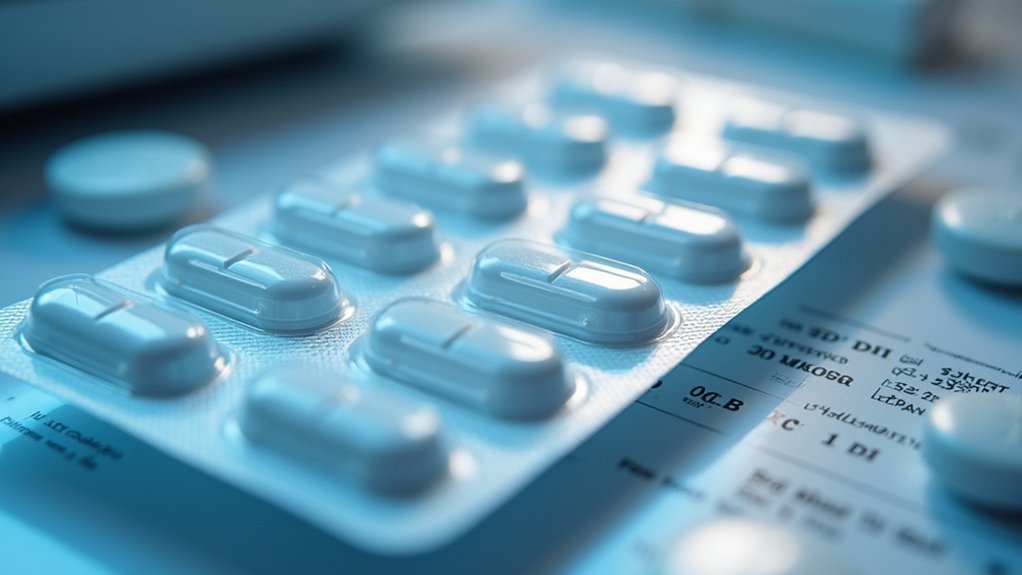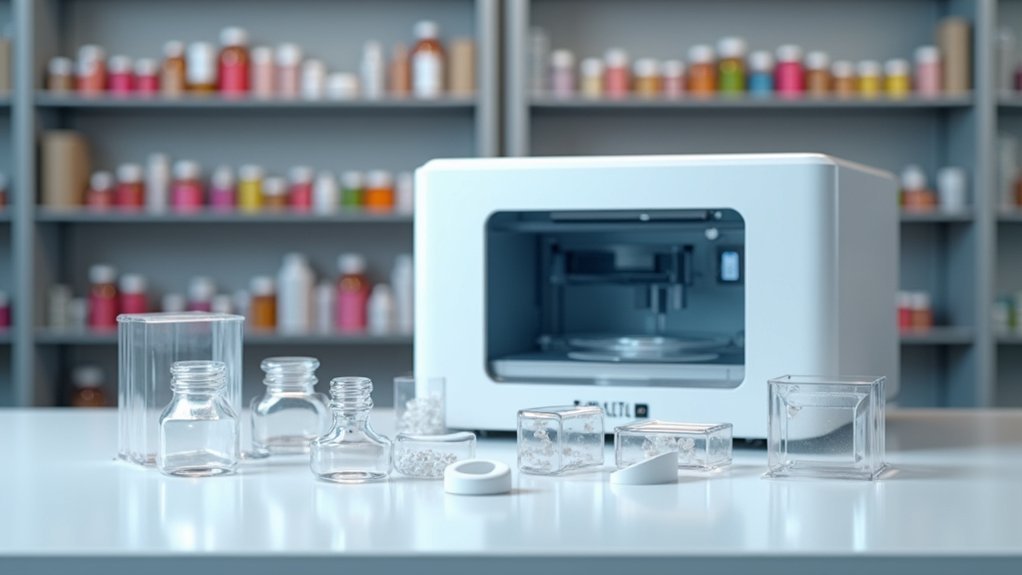You’ll revolutionize pharmaceutical packaging by using 3D printing to create personalized containers tailored to each patient’s specific needs, including Braille markings and ergonomic designs for better accessibility. This technology enables on-demand manufacturing that eliminates waste, reduces inventory costs, and responds instantly to market demands. You can integrate smart monitoring features like IoT sensors for real-time tracking while ensuring tamper-evident security and FDA compliance. Advanced barrier properties protect medications from environmental damage, and local production considerably cuts transportation costs and carbon footprints, making your operations more sustainable and efficient than traditional methods.
Enhanced Customization for Patient-Specific Needs

While traditional pharmaceutical packaging follows a one-size-fits-all approach, 3D printing revolutionizes how you can tailor medication containers to individual patient requirements. This technology enables personalized packaging designs that directly address your specific needs and preferences.
You’ll find custom packaging incorporates essential accessibility features like Braille markings and visual aids, making medications more manageable for visually impaired patients. The ergonomic designs facilitate easier handling, reducing your risk of dosing errors while improving overall user experience.
You can also benefit from audible reminders integrated into packaging that help maintain medication schedules. Size and shape adjustments guarantee containers fit your lifestyle, creating a truly patient-centric pharmaceutical packaging solution.
On-Demand Manufacturing Reduces Waste and Lead Times
You’ll eliminate costly inventory overstock issues when you adopt on-demand 3D printing for pharmaceutical packaging, producing only what’s needed when it’s needed.
Your production capabilities become remarkably rapid, allowing you to respond swiftly to market demands and regulatory changes without maintaining extensive stockpiles.
This approach dramatically minimizes material waste since you’re not overproducing packaging that might become obsolete or expire before use.
Eliminates Inventory Overstock Issues
Because traditional pharmaceutical packaging requires large production runs and extended lead times, companies often face costly inventory overstock situations that 3D printing technology effectively eliminates.
With on-demand manufacturing, you’ll produce packaging only when needed, removing the guesswork from demand forecasting and preventing excess inventory accumulation.
You’ll greatly reduce carrying costs associated with storing surplus packaging materials while avoiding write-offs from expired or obsolete inventory.
The flexibility of 3D printing means you can adjust production volumes instantly based on actual prescription patterns rather than predictions. This responsive approach guarantees you’re not stuck with warehouse space filled with unused packaging.
On-site production capabilities allow healthcare facilities to maintain lean inventory levels, eliminating the financial burden of stockpiling while guaranteeing packaging availability matches real-time medication demands perfectly.
Rapid Production Capabilities
When pharmaceutical companies need packaging immediately, 3D printing delivers results within hours rather than weeks or months required by traditional manufacturing methods.
This rapid production capability transforms how you approach pharmaceutical packaging by eliminating lengthy lead times that traditionally slow down operations.
You’ll benefit from 3D printing’s immediate responsiveness in several key ways:
- Instant design modifications – Adjust packaging specifications without retooling production lines
- Emergency production runs – Meet urgent demands when traditional suppliers can’t deliver
- Prototype acceleration – Test new designs within the same day rather than waiting weeks
- Supply chain independence – Reduce reliance on external manufacturers and global shipping delays
This technology’s rapid production capabilities enable you to maintain consistent pharmaceutical packaging availability while responding quickly to market demands and regulatory requirements.
Material Waste Minimization
Material waste reaches staggering levels in traditional pharmaceutical packaging manufacturing, where excess inventory and overproduction create environmental and financial burdens.
3D printing’s on-demand approach eliminates this inefficiency by producing only the exact quantities you need, when you need them.
The additive manufacturing process uses material layer by layer, consuming only what’s necessary for each pharmaceutical packaging item.
You’ll eliminate the waste associated with subtractive methods that cut away excess material. Through precise customization, you can create packaging tailored to specific dimensions, reducing unnecessary components.
Rapid prototyping capabilities let you optimize designs without generating unused samples.
You’ll achieve shorter production runs with faster turnaround times, decreasing lead times while minimizing environmental impact from overproduction.
Advanced Safety Features Through Innovative Design
As pharmaceutical companies face mounting pressure to combat counterfeiting and guarantee patient safety, 3D printing technology offers unprecedented opportunities to embed sophisticated security measures directly into packaging design.
This revolutionary approach transforms traditional packaging into intelligent protective barriers that actively safeguard medications and patients alike.
Your 3D printing implementation enables four critical advanced safety features through customizable designs:
- Tamper-evident structures – Complex geometries that visibly reveal unauthorized access attempts
- Smart monitoring integration – Real-time tracking of temperature and humidity to ascertain drug stability
- Ergonomic safety elements – User-friendly features that prevent accidental misuse and improve handling
- Enhanced barrier protection – Sophisticated designs that shield medications from light and moisture damage
These innovations deliver thorough protection while supporting personalized dosing solutions for improved patient adherence.
Regulatory Compliance and Quality Assurance Benefits

You’ll find that 3D printing technology helps pharmaceutical companies meet FDA approval standards by enabling precise customization of packaging designs that address specific regulatory requirements.
Your quality control processes become more robust when you integrate real-time monitoring capabilities and tamper-evident features directly into the packaging structure.
You can implement extensive safety protocols more effectively through 3D printing’s ability to create packaging with enhanced barrier properties and contamination prevention measures.
FDA Approval Standards
When you’re developing 3D-printed pharmaceutical packaging, understanding FDA approval standards becomes essential for ensuring your products meet regulatory requirements.
The FDA’s evolving regulatory framework specifically addresses additive manufacturing processes, helping you navigate compliance for pharmaceutical applications.
Here’s what you need to know about FDA approval standards:
- Rigorous Testing Requirements – Your packaging must undergo thorough safety, efficacy, and material compatibility testing to meet FDA standards.
- Innovative Feature Integration – Compliance enables you to incorporate tamper-evident designs and smart packaging technologies that enhance medication safety.
- Quality Assurance Protocols – Clear approval standards help maintain consistent quality while encouraging personalized packaging solutions.
- Collaborative Approach – Ongoing FDA-manufacturer partnerships facilitate safe market deployment of your 3D-printed packaging innovations.
Quality Control Processes
While traditional packaging methods often struggle to maintain consistent quality metrics throughout production, 3D printing revolutionizes quality control processes by enabling real-time monitoring and immediate adjustments during manufacturing.
You’ll benefit from enhanced oversight that guarantees every package meets stringent safety and efficacy standards critical for regulatory compliance.
With 3D printing, you can produce customized packaging that incorporates advanced materials and design capabilities, improving barrier properties that protect medications from environmental factors.
You’ll also integrate tamper-evident features directly into your packaging design, enhancing safety while meeting anti-counterfeiting regulations.
This technology allows you to adapt quickly to specific regulatory requirements, making compliance more efficient than traditional methods while maintaining the highest quality standards throughout your pharmaceutical packaging operations.
Safety Protocol Implementation
Because pharmaceutical packaging demands unwavering adherence to safety protocols, 3D printing transforms how you’ll implement and maintain regulatory compliance throughout your manufacturing process.
You’ll achieve superior safety standards through:
- Tamper-evident integration – Built-in security features that prevent counterfeiting and protect product integrity from manufacturing to end-user.
- Contamination risk reduction – Precise manufacturing control that aligns with Good Manufacturing Practices (GMP) by minimizing exposure points.
- Real-time monitoring capabilities – Embedded sensors that instantly detect environmental factors threatening medication stability.
- Rapid compliance validation – Quick prototyping allows immediate testing against regulatory standards with swift adjustments based on quality feedback.
This technology guarantees you’re meeting stringent safety requirements while customizing solutions for specific medications.
Your regulatory compliance becomes proactive rather than reactive, establishing robust safety protocols that protect both products and patients.
Environmental Protection and Barrier Properties

Although traditional pharmaceutical packaging often relies on standardized designs that may not suit every medication’s specific requirements, 3D printing revolutionizes how you can protect drugs from environmental threats.
This technology enables you to create packaging with enhanced barrier properties that shield medications from humidity and light exposure, which typically degrade drug efficacy.
You’ll benefit from custom-designed solutions optimized for your specific products, ensuring minimal material use while maintaining structural integrity.
The additive manufacturing process lets you integrate smart packaging features like moisture-absorbing materials that actively prevent contamination.
Through precise production, you’ll reduce excess waste by creating packaging tailored to exact medication dimensions, minimizing surplus materials and decreasing transportation-related carbon footprints through on-demand production capabilities.
Smart Packaging Integration for Real-Time Monitoring
You can transform your pharmaceutical packaging into an intelligent monitoring system by integrating IoT sensors directly into 3D printed designs.
These sensors continuously track critical parameters like temperature, humidity, and light exposure, ensuring your medications maintain their potency throughout storage and transport.
You’ll receive real-time alerts on your smartphone if environmental conditions threaten drug stability, allowing immediate corrective action to protect pharmaceutical integrity.
Real-Time Drug Monitoring
The integration of smart sensors and IoT technology into 3D-printed pharmaceutical packaging transforms traditional containers into intelligent monitoring systems that actively safeguard drug integrity.
Real-time monitoring capabilities guarantee your medications maintain ideal conditions throughout their lifecycle, while smart packaging delivers instant alerts when environmental parameters exceed safe thresholds.
This technology enhances drug safety through:
- Temperature and humidity tracking – Continuous monitoring prevents degradation from environmental exposure
- Tampering detection – Immediate notifications protect against contamination or unauthorized access
- Patient adherence support – Automated reminders and dosage notifications reduce medication errors
- Supply chain enhancement – Real-time data enables efficient distribution and reduces pharmaceutical waste
You’ll access extensive medication information through QR codes or NFC technology, guaranteeing proper storage and usage while maintaining regulatory compliance standards.
IoT Sensor Integration
When pharmaceutical manufacturers embed IoT sensors directly into 3D-printed packaging materials, they create intelligent containers that continuously monitor critical parameters affecting drug stability.
You’ll benefit from real-time temperature and humidity tracking that instantly alerts you to environmental deviations, protecting medication integrity throughout the supply chain. This IoT sensor integration enables your packaging to communicate directly with inventory management systems, optimizing stock control and reducing pharmaceutical waste.
With 3D printing, you can customize sensor placement within package walls, creating tamper-evident designs that track patient adherence patterns.
Your pharmaceutical manufacturing process gains enhanced regulatory compliance through verifiable monitoring data, while patients receive personalized medication management.
These smart packaging solutions transform traditional containers into active guardians of drug quality, ensuring therapeutic effectiveness from production to consumption.
Accessibility Features for Diverse Patient Populations
How can pharmaceutical packaging truly serve every patient when traditional designs often overlook the diverse needs of different populations?
3D printing revolutionizes accessibility by enabling manufacturers to create customized packaging that addresses specific challenges faced by visually impaired, cognitively impaired, and physically limited patients.
These accessibility features transform how patients interact with their printed medicines through personalized packaging designs that meet individual needs:
- Braille markings – You can identify medications independently without relying on others for assistance.
- Visual aids and color coding – Clear symbols help you understand dosing instructions despite cognitive impairments or language barriers.
- Ergonomic designs – Easy-open containers accommodate your limited dexterity or arthritis.
- Audible reminders – Built-in audio cues guarantee you never miss doses or medication schedules.
Cost-Effectiveness and Infrastructure Advantages
Beyond improving patient accessibility, 3D printing delivers substantial economic benefits that reshape pharmaceutical manufacturing economics. You’ll reduce packaging costs through on-demand production, eliminating extensive inventory requirements and minimizing waste. The cost-effectiveness extends beyond materials—you’re cutting transportation expenses through local manufacturing capabilities.
| Traditional Packaging | 3D Printing Advantages | Cost Impact |
|---|---|---|
| Large inventory storage | On-demand production | Reduced overhead |
| Multiple packaging lines | Customized packaging solutions | Lower setup costs |
| Distant manufacturing | Local manufacturing hubs | Decreased shipping |
You can integrate compact 3D printers directly into pharmacies, streamlining operations without requiring large facilities. This technology enables customized packaging solutions tailored to specific products while maintaining complex designs that protect against environmental factors, ultimately extending shelf-life and preserving pharmaceutical efficacy.
Material Efficiency in Additive Manufacturing Processes
Since additive manufacturing builds products layer by layer, you’ll achieve remarkable material efficiency that traditional packaging methods can’t match. Unlike subtractive manufacturing that wastes excess material, 3D printing uses only what’s necessary for each product.
You’ll benefit from these material efficiency advantages:
- Zero waste production – Materials are deposited precisely where needed, eliminating scrap and excess.
- Complex geometry optimization – Create intricate designs that maximize space utilization and reduce material usage.
- Custom batch sizing – Print exactly what you need, reducing inventory waste and excess packaging materials.
- Multi-material integration – Combine different materials in single prints for enhanced functionality without compromising efficiency.
This approach transforms how you develop packaging solutions, enabling sustainable practices while maintaining pharmaceutical industry standards and regulatory compliance.
Tamper-Evident and Anti-Counterfeiting Capabilities
Your 3D printing capabilities extend beyond efficient material usage to create sophisticated security features that protect pharmaceutical products from tampering and counterfeiting.
You can integrate advanced tamper-evident packaging features directly during production, making unauthorized access visually obvious to consumers. The technology allows you to embed unique anti-counterfeiting elements like QR codes and holograms that counterfeiters can’t easily replicate.
You’ll benefit from creating complex geometries that deter tampering through innovative design solutions.
Smart technologies can be incorporated, including sensors that alert users when packaging integrity has been compromised.
With 3D printing, you can produce smaller specialized batches of secure packaging, reducing counterfeit medication risks in your supply chain while maintaining cost-effectiveness for unique security requirements.
Future-Ready Technology for Pharmaceutical Innovation
While traditional packaging methods struggle to keep pace with evolving pharmaceutical needs, 3D printing positions you at the forefront of innovative solutions that adapt to tomorrow’s challenges.
This future-ready technology transforms pharmaceutical packaging by enabling unprecedented customization and functionality. You’ll benefit from:
- Smart integration capabilities that incorporate real-time monitoring sensors directly into packaging designs for enhanced medication tracking
- On-demand manufacturing flexibility that reduces waste while allowing rapid adaptation to new drug formulations and regulatory requirements
- Complex geometric designs that provide superior protection against environmental factors like humidity and light exposure
- Accessibility-focused features including Braille textures and audible reminder systems that improve patient adherence across diverse populations
3D printing empowers you to create pharmaceutical packaging that evolves with medical advances, ensuring your products remain competitive in an increasingly sophisticated healthcare landscape.
Frequently Asked Questions
What Is the Purpose of 3D Printing in Medicine?
You’ll customize medications precisely for individual patients, create complex drug combinations impossible with traditional methods, accelerate development timelines, reduce manufacturing waste, and enable innovative smart packaging solutions that improve treatment outcomes.
How Does 3D Printing Improve the Sustainability of Pharmaceutical Manufacturing?
You’ll reduce transportation emissions through localized manufacturing while minimizing material waste with additive processes. You can customize packaging designs to use fewer materials and integrate smart technologies that extend shelf life naturally.
How Is 3D Printing Being Used in the Packaging Industry?
You’re using 3D printing in packaging to create customized solutions, complex protective structures, and on-demand production. It reduces inventory costs, incorporates smart sensors, and enables sustainable practices through minimal waste.
What Are the Advantages of Using 3D Printing?
You’ll achieve greater design flexibility, reduce material waste, and create customized solutions faster. You can produce complex geometries impossible with traditional methods, lower production costs, and rapidly prototype new ideas.





Leave a Reply